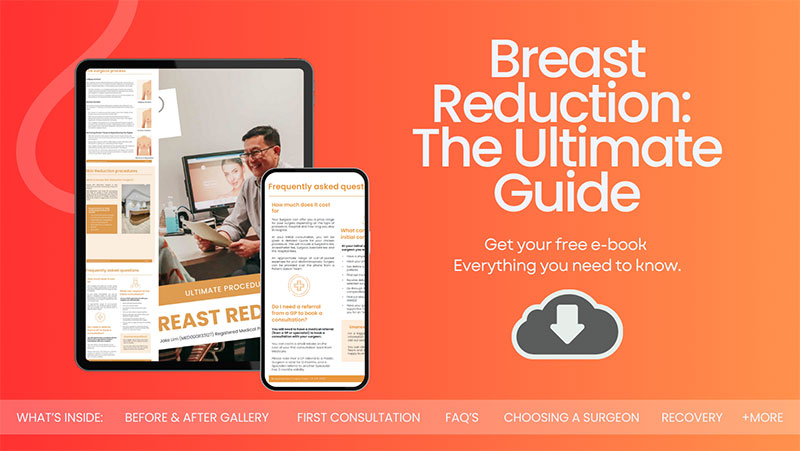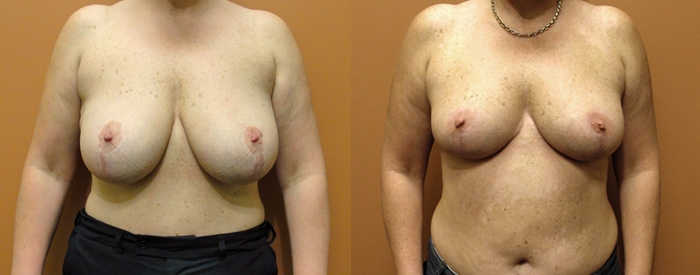Scar Reduction Options after Breast Reduction Surgery
When you decide to undergo a breast reduction surgery, you’re making a significant decision that can have a profound impact on your health and wellbeing. While the benefits of this procedure, such as reduced pain and discomfort are substantial, you will develop breast reduction scars. These scars can often be a source of concern, detracting from the positive outcomes of the surgery. However, it’s essential to remember that scarring is a natural part of the body’s healing process and is unavoidable after any surgical procedure.
Nonetheless, the extent and visibility of these scars can be minimised with proactive measures and a comprehensive post-operative care plan. This blog aims to provide you with a detailed understanding of why scars form after a breast reduction surgery, the proactive measures, products, and therapies to minimise scarring, and the importance of follow-up consultations for effective scar management.
Sydney Plastic Surgeon Dr Jake Lim performs breast reduction surgery and other breast and body procedures.
Dr Lim’s 2024 Breast Reduction Guide

Why Do Scars Form after Breast Reduction Surgery?
Breast reduction scars form as a result of the body’s natural healing process. When your body undergoes surgery, the skin’s integrity is compromised, and your body responds by producing collagen fibres to repair the damage. These collagen fibres form a scar, which initially appears red and raised but gradually fades over time to a less noticeable white or silvery hue.
The size, shape, and visibility of your scars will depend on several factors, including your age, skin type, genetics, and the surgical technique used during the procedure. While it’s impossible to prevent scarring entirely, understanding why they form can help you implement effective strategies to reduce their appearance.

Different Types of Breast Reduction Incisions and How They Affect Recovery
The type of incision used during the procedure can influence both the surgical outcome and the recovery process. Here are the different types of incisions used in breast reduction surgery and how they affect recovery:
- Circular or Periareolar Incision:
- Description: This incision is made around the areola
- Recovery Impact: This method often results in less visible scarring as the incision blends with the natural border of the areola. However, it’s typically used for patients requiring minimal tissue removal. Recovery may be quicker with less extensive incisions, but there might be limitations in the amount of reduction achievable
- Keyhole or Lollipop Incision:
- Description: This technique involves an incision around the areola and a vertical incision from the bottom of the areola to the breast crease, resembling a lollipop
- Recovery Impact: The lollipop incision allows for moderate tissue removal. While there’s more scarring than the periareolar method, scars can fade over time and are positioned in less noticeable areas. Recovery might be moderate in terms of swelling and discomfort due to the additional vertical incision
- Anchor or Inverted-T Incision:
- Description: This is the most common technique for breast reduction. It combines the lollipop incision with a horizontal incision along the breast crease, forming an anchor or inverted-T shape
- Recovery Impact: This method allows for the most significant tissue removal and reshaping. As a result, it’s ideal for patients requiring substantial reduction. But it involves more extensive scarring. Recovery might be slightly longer due to the larger incision area, with increased swelling and discomfort initially. Proper wound care is essential to minimise scar appearance
- Liposuction-Only Breast Reduction:
- Description: For patients whose primary concern is excess fatty tissue rather than glandular tissue, liposuction can be used for breast reduction. Small incisions are made to insert the liposuction cannula
- Recovery Impact: This method results in minimal scarring and a quicker recovery time compared to other techniques. It’s suitable only for specific cases where skin elasticity is good, and there’s minimal excess skin
Recovery Implications Based on Incision Type
- Scarring: The visibility and extent of scarring largely depend on the incision type. While all surgical procedures result in some scarring, proper post-operative care, including scar creams and silicone sheets, can help in reducing their appearance
- Pain and Discomfort: Larger incisions might result in increased pain and discomfort initially. Pain management, including prescribed medications, can help in alleviating these symptoms
- Swelling and Bruising: More extensive incisions might lead to increased swelling and bruising, which gradually subsides over weeks
- Sensation: Changes in nipple and breast sensation can occur, especially with incisions around the areola. Sensation returns over time, but there’s a risk of permanent changes
The choice of incision type is based on the patient’s anatomy, the amount of reduction desired, and the plastic surgeon’s expertise. It’s essential to discuss the pros and cons of each method with a specialist plastic surgeon Dr Jake Lim to determine the best approach for individual needs.
Measures to Minimise Scarring
The first step to reducing the visibility of your breast reduction scars is to take proactive measures. One of the most important aspects of this is adhering to a comprehensive post-operative care plan.
This involves keeping the incision sites clean, applying prescribed ointments or creams, wearing appropriate support garments, avoiding strenuous activities, and refraining from smoking or drinking alcohol, which can hinder the healing process.
Maintaining a healthy diet rich in vitamins and minerals can also contribute to effective wound healing and scar minimisation. Key nutrients that promote healing include vitamin C, zinc, and protein.
Post-Operative Care for Scar Minimisation
Post-operative care plays a pivotal role in scar minimisation. Following Dr Lim’s instructions for wound care and recovery can significantly impact how your scars heal and their eventual appearance.
Dr Lim will recommend keeping the incision sites clean and dry for the first few days, only applying topical creams to promote healing and reduce inflammation after 3 weeks when the adhesive tapes have been removed, and wearing supportive garments to maintain the shape of your breasts and minimise strain on the incision sites.
Additionally, it’s essential to avoid exposing your scars to the sun, as this can darken them and make them more noticeable. If you must go outside, ensure to cover your scars with clothing or use a high-SPF sunscreen.
Scar Minimization Options: Products and Therapies
There’s a wide range of products and therapies available that can help reduce scars after breast reduction. Topical creams and gels containing ingredients like silicone and vitamin E can help soften, flatten, and fade scars.
In addition to topical treatments, there are also several therapies that can improve the appearance of scars. These include laser therapy, which can reduce redness and improve texture; micro-needling, which can stimulate collagen production and improve scar texture; and dermabrasion, which can smooth the surface of the skin and improve the appearance of scars. LED light therapy may also assist with healing of wounds and scars.
Natural Remedies for Reducing Scars after Breast Reduction
Natural remedies can also be an effective way to reduce scars after breast reduction. Ingredients like aloe vera, honey, and coconut oil have been shown to have healing properties that can improve the appearance of scars.
While these natural remedies can be beneficial, it’s essential to discuss them with your plastic surgeon before use, as they may not be suitable for everyone and can potentially interfere with other treatments or medications.
Follow-Up Consultations for Scar Management
Follow-up consultations are important for effective scar management. These appointments provide your plastic surgeon with the opportunity to monitor your healing progress, assess the development of your scars, and adjust your treatment plan as necessary.
During these consultations, it’s important to voice any concerns or questions you may have about your scars. Your plastic surgeon can provide you with valuable advice and reassurance, ensuring that you’re on the right track to achieving the best possible outcome.
If you’re concerned about the appearance of your breast reduction scars, scar minimisation options can provide you with a range of advanced treatments and therapies to improve their appearance.
These options often employ a multidisciplinary approach, combining various treatments to achieve the best results. These may include advanced laser therapies, LED light therapy, medical-grade skincare products (Rationale Skin Care), and professional guidance on lifestyle modifications that can improve healing and reduce scarring.
FAQs about Scars Minimisation Options after Breast Reduction Surgery

Q. What to expect 4 weeks after breast reduction?
Four weeks post breast reduction surgery, most patients will notice a significant decrease in swelling and discomfort. The incisions will have started to heal, and the overall shape of the breasts will begin to settle. While the breasts may still be tender to the touch, many patients can resume light activities and return to work, provided it doesn’t involve heavy lifting or strenuous exercise.
Q. What happens 2 weeks post op breast reduction?
Two weeks after breast reduction surgery, patients will still be in the recovery phase. Swelling and bruising may still be present, but they will have reduced compared to the initial days post-surgery. Stitches may be removed around this time, depending on the plastic surgeon’s advice. It’s essential to continue wearing the surgical bra and avoid any intense activities.
Q. When can I go braless after breast reduction?
Going braless after a breast reduction is usually advised after 12 weeks post-surgery. However, it’s essential to consult with Dr Lim before making this decision. The surgical bra helps in supporting the breasts during the healing process, so it’s crucial not to rush this step.
Q. What not to do after breast reduction surgery?
After breast reduction surgery, avoid strenuous activities, heavy lifting, and vigorous exercises for at least 6 weeks. It’s also essential to avoid sleeping on your stomach, smoking, and exposing the incision sites to direct sunlight. Always follow Dr Lim’s post-operative care instructions closely.
Q. How long after breast reduction will I know my size?
The final breast size and shape will typically settle around 3-6 months post-surgery. While initial swelling will reduce in the first few weeks, the tissues and skin will take some time to adjust to their new contours.
Further Reading about Breast Surgery with Dr Lim
- Read Dr Lim’s Breast Reduction Surgery Page
- Read Dr Lim’s Nipple Reduction Surgery Page
- Read Dr Lim’s Blog about Compression Bras after Breast Reduction Surgery
- Read Dr Lim’s Does Medicare Cover Breast Reduction Surgery?
- See Dr Lim’s Before and After Photo Gallery
- Read Dr Lim’s blog about Efficient Methods to Reduce Bruising after Breast Reduction Surgery




